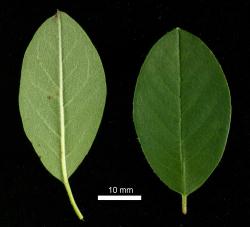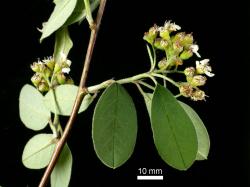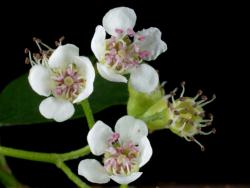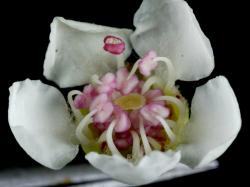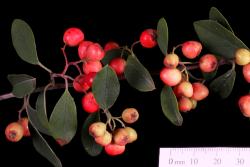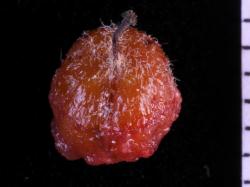- = Cotoneaster hebephyllus var. monopyrenus W.W.Sm., Notes Roy. Bot. Gard. Edinburgh 10: 23 (1917)
- ≡ Cotoneaster monopyrenus (W.W.Sm.) Flink & B.Hylmö, Bot. Not. 119: 459 (1966)
Erect shrub 2.5–5 m tall, deciduous. Branches arched and spreading; branchlets red-brown to purple-brown, glossy, peeling cuticle present, branchlet hairs dense to sparse, white, woolly; stipule 2.5–5.5 mm long, red, with hairs moderately dense to sparse, white. Leaves sparse on branches, 36–57 mm long, lamina 31–46 mm long, 18–24 mm wide, ellipsoidal to obovate, plane or slightly V-shaped, 220–250 µm thick, petiole 5–14 mm long, hairs dense, white; leaf base obtuse; leaf apex obtuse and cuspidate with a straight apiculus; lateral veins in 4–7 pairs, midvein and base of lateral veins impressed above and projecting below; upper surface smooth, dark yellowish-green (RHS 136B), dull, upper surface hairs either confined to midvein or sparse on the surface; margins plane, hairs dense, white; lower surface glaucous, hairs moderately dense to dense, white, fine, straight to woolly.
Inflorescence a compound corymb of 19–24 flowers, 33–35 mm long, rachis hairs moderately dense, white; pedicel 2.5–3.0 mm long, hairs moderately dense, white. Flowers 9.0 mm diameter. Hypanthium green, sepals 1.0–1.3 mm long, 2.2–2.5 mm wide, red at apex, hairs sparse to moderately dense, white. Petals white in bud, spreading and white when open, 2.9 mm long, 3.1–3.2 mm wide, base slightly clawed, tuft of hairs present, margins entire. Stamens 19–20; filaments 2.0 mm long, white; anthers pink to pinkish-purple, 0.8–0.9 mm long; styles 1, rarely 2, 2.0–2.5 mm long. Fruit vivid reddish-orange (RHS 34A), obovoid, 6.6–7.0 mm long, 6.7–7.9 mm diameter, calyx closed, hairs glabrous. Pyrenes 1, rarely 2, 3.5–3.8 mm long, 3.0–4.7 mm wide, hairs sparse at apex, style attached at centre of pyrene apex.
A deciduous, erect shrub. Leaves 6–40 mm long, elliptic, midvein only impressed. Hairs on lower leaf surface moderately dense and more or less persistent, fine, almost straight. Corymbs of 19–24 flowers. Hypanthium hairs sparse. Petals white, spreading, with a tuft of hairs at the inner petal base. Styles 1 or 2 fused. Fruit red, pyrenes usually 1, rarely 2.
Most similar to Cotoneaster soongoricus in the size of the shrub, the sparse branching and leaves, the non-glossy mid green upper leaf surface with few hairs on either surface, flowers in corymbs of 19–24, petals, white and spreading with a tuft of hairs at the petal base. The leaves of C. hebephyllus are elliptic rather than orbicular, and the anthers pink, not white. Hypanthium hairs are usually sparse (densely white-tomentose in C. soongoricus). The fruit of C. hebephyllus contains 1 pyrene, but usually 2 in C. soongoricus. Neither species is common in cultivation in New Zealand but of the two, C. hebephyllus is more common.
Gisborne (Eastwoodhill Arboretum) and Canterbury (Victoria Park). In Victoria Park it grows under low forest of mixed native and non-native trees and appears to be self-seeded as plants are small (1 m or less). In cultivation at Abberley Park, Christchurch (2016), Victoria Park (2016), Christchurch City, Cashel Street (1987), Christchurch Botanic Gardens (1962–1987).
Listed as casual in Heenan et al. (1999, p. 637 as "Cotoneaster cf. monopyrenus Diels"), based on CHR 463186, W.R. Sykes 326/89, 18 June 1989, Eastwoodhill Arboretum. Also cited in Heenan et al. (1999) is CHR 513510, W.R. Sykes 194/97, 8 May 1997, Port Hills. Both are C. hebephyllus as C. monopyrenus is a synonym of C. hebephyllus in Lu & Brach (2003), a decision followed here.
CHR 463186, W.R. Sykes 326/89, 18 June 1989, Eastwoodhill Arboretum.
Flowering: mid-October to early December; Fruiting: mid-February to March
Triploid using flow cytometry result from CHR 638082. Ploidy not stated in Fryer & Hylmö (2009).



